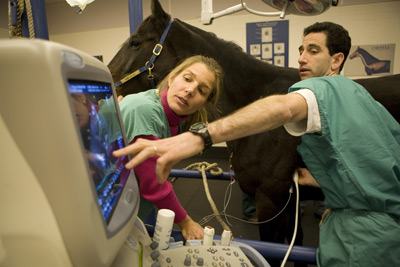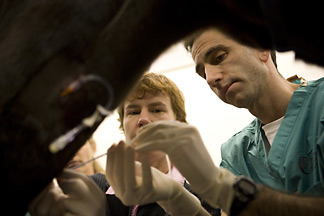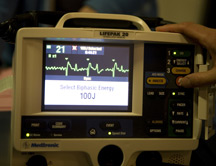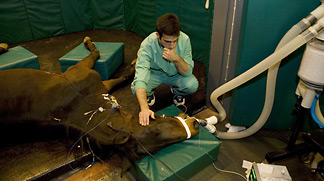New heart procedure helps Hard Hitter get back in the race
By Lauren Gold




The patient who came to the Cornell University Hospital for Animals to see veterinary cardiologists Anna Gelzer and Marc Kraus Nov. 7 didn't appear particularly sick.
He stood quietly in the exam room as students and doctors pressed stethoscopes to his chest and chatted. If he knew he was there for a sophisticated new procedure, he gave no indication.
He sighed. As the morning wore on, his eyelids began to droop. He seemed, simply, bored.
Hard Hitter, a gentle, amiable brown racehorse with calm, dark eyes, came to Cornell after uncharacteristically dropping out of a race in Saratoga Springs. He was diagnosed with atrial fibrillation, a condition causing his heart to lose efficiency under stress, leaving him short of breath and unable to run.
Doctors recommended internal electric cardioversion, a procedure to shock his heart back into normal rhythm. Cornell is one of just a few facilities in the country to offer the treatment, with about a dozen horses treated so far -- all with success.
Hard Hitter would add another positive outcome to the record. But in his case the procedure would take much longer than usual -- and would lead to the discovery of a new technique.
Atrial fibrillation, in which the heart's upper chambers (atria) quiver, causing ineffective heart contractions, is common in horses -- as well as in humans with other heart ailments. In horses it usually occurs in otherwise healthy hearts.
Pasture horses can live full lives with atrial fibrillation. But afflicted racehorses in the past were treated with quinidine, an anti-arrhythmic drug that often causes severe side effects and doesn't always work. For Hard Hitter and his generation of racehorses, though, cardioversion is a new, quick, relatively painless procedure -- costing about $1,700 -- that gets otherwise healthy horses back into racing shape in just a few weeks.
Hard Hitter would be given an internal shock via two catheters threaded through his blood vessels into carefully chosen spots in his heart. He would be under general anesthesia for the shock -- but first he had to be awake and standing as doctors positioned the catheters.
And this is a tricky job: Working with horse-sized (i.e., gigantic) tools, Gelzer and resident Sophy Jesty inserted two catheters fitted with shock-delivering coils into Hard Hitter's neck, where his skin had been anesthetized. Kraus pushed an ultrasound receiver into the horse's chest and on a screen watched one catheter make its way toward the heart's right atrium and the other to just above the heart in the left pulmonary artery. The locations allow the current to reach the largest possible area of the atrial wall without affecting other regions of the heart.
The crew then lined the obliging horse up against the back wall of a green-padded cell. An anesthesiologist looped his halter lead and a rope tied to his tail over two hooks. Vet students lined up beside him, feet braced and hands out. The anesthesiologist administered a shot -- and the 950-pound animal fell gently, backwards and down.
Gelzer administered the first shock to the heart: 100 joules. She and the team peered at the electrocardiogram (EKG) monitor -- and shook their heads. Like many horses, Hard Hitter would require more than one shock.
A second try failed, and a third. The EKG wasn't changing. The cardiologists consulted X-rays and ultrasound images, adjusted the positioning of the leads and tried again. Still no luck.
Then Gelzer had an idea: inject harmless saline solution through the catheters. This would provide contrast in the ultrasound imaging and better show the exact location of the leads. They gave it a try -- and almost immediately they saw that one lead was in a little too far.
They repositioned the lead, tried again. And -- voila. Normal sinus rhythm.
"We learn something new every time," said Kraus (after cheers subsided). Gelzer's trick now will be incorporated into standard protocol, he added.
As for Hard Hitter, he stayed overnight for monitoring, then hit the road back to Saratoga. And now -- just a few weeks later -- he's back to light training. Chances are 60 percent that the fix will be permanent.
Gelzer, Kraus, Jesty and colleagues are used to working without a thank you from their patients. But if they wonder if Hard Hitter appreciates their work -- they can check out a letter from one of his fellow cardioversion recipients.
"Thank you for all you did for me," reads the letter, written (ahem) by a satisfied former patient who underwent the procedure a few months earlier. "I trotted a mile in 1:58:2 and won the race at Saratoga Raceway. I have enclosed a win photo ... yeah, that's me!"
Media Contact
Get Cornell news delivered right to your inbox.
Subscribe